I ordered the parts from the local motor factors that we normally use who are able to look up the vehicle based on registration number. Turns out their system is flawed and the parts they supplied were for the single wheel Sprinters. I then went to another supplier, ditto, same thing. I decided to stop wasting my time and went straight to Mercedes and walked out with rights parts 10 minutes after walking in. Strangely while my arms were loaded down with 2 really heavy discs and a set of pads, my wallet felt lighter by the same amount.
Please Note/Disclaimer: This article is a description of the work I did to my vehicle and in no way constitutes advice to work on your own. If you are not an experienced mechanic then please get an experienced mechanic to work on your vehicle for you. No liability can be accepted for anyone attempted to replicate anything shown on this blog.
This job was started by chocking the vehicle, jacking it up, putting some stands under and removing the rear wheels (one side at a time). The handbrake was released and cable cam adjuster (underneath in the center of the vehicle slackened off.
I proceeded to remove the 'wheel carrier' (for want of a better name), the caliper and the caliper bracket. The wheel carrier is removed by removing 6 19mm bolts located around the center of hub. The bolts came loose easily, but I needed to 'tap' the carrier with a 4 pound hammer to get it to pop off.
The caliper comes off the bracket by removing two 13mm bolts from the sliders which need to be held with a 17mm spanner. I tied the caliper up and rested it on the leafspring to ensure flexi hose didn't twist or become damaged. This came off easily. The old pads can be removed at this time.
The caliper bracket is held on with two 19mm bolts. The lower one came loose after only about 30 mins of fighting with it. This involved copious amounts of easing fluid (I didn't mind contaminating anything in brakes as all were being replaced). The upper one onf the other hand required copious spraying, lots of swearing, heaving and pulling on a long cracker bar. As I had started the one side the night before, it benefitted from having been sprayed some hours before and then soaking. For the other side I didn't want to wait 12 hours so after much effort I eneded up heating it with a blow torch. (CAREFULLY: I made sure I had a fire extinguisher, and directly the blow torch only at the bracket which wasn't near any seals or brake parts - the caliper already have been safely moved out of the way).
For each side I spent as much time on the top caliper bracket bolt as on the rest of the stripdown put together.
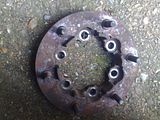

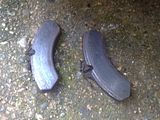

I then proceeded to remove the disc. First ensuring the vehicle was out of gear so the disc could rotate. This allowed me to slacken off the adjustment on the shoes to ensure they weren't binding on the drum section. As the drums wear and dirt and rust builds up a slight ridge is formed on the rear which can grip the shoes. Even with the adjuster totally slackened off and being able to see that the shoes were free (see pictures), it still took a lot of 'tapping' with the 4lb hammer to get the disc off as it has a reasonably close fit on the hub.

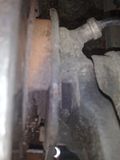
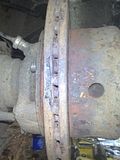
On removal of the disc I was able to properly inspect and then remove the handbrake shoes. I took pictures of these in situ in order to ensure that I didn't get the springs, etc confused but they are all pretty straightforward.
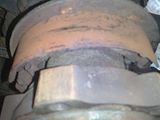
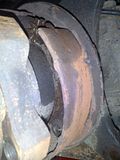
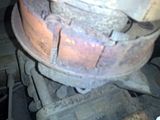
As can be seen from the pictures the shoes were totally down to the metal and had been eating away at the drum section of the disc.
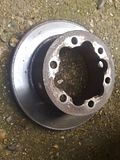
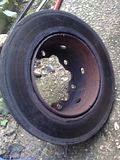
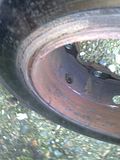
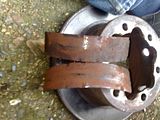
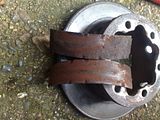
In preparation for the re-assembly I stripped down the adjuster. It pulls apart and the toothed section can be unscrewed. I then coated all the working parts with anti-seize compound and worked them back and forth onre-assembly to ensure that the fully working range was free. I also unpacked the new shoes at this point and took a 'new vs old' picture.
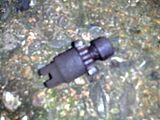

Re-assembly of the brake system then began by fitting the new shoes, this is simply a 'Haynes manual' approach of reversing the disassembly procedure (BTW: I didn't have a manual so tackled this using common sense and the advise of the friend on specifics, but I do have extensive experience of working on cars as a hobby). Make sure that the adjuster is wound back fully.
To assist with hooking the springs in I took an old coat hanger and fashioned a hook with it (a trick my father used in the lifetime he spent running a commercial garage).
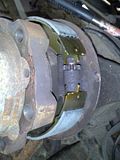
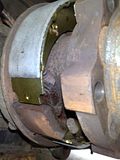
Next up the new disc went on. This was first cleaned with some 'brake and clutch' cleaner to ensure it wasn't covered in oil/grease. Having said that I found these (Mercedes) discs to appear to be a lot cleaner than the motor factor supplied discs on which you tend to detect the protective layer. Mercedes supply these in a protective plastic bag inside the box.
Before bolting on the wheel carrier I cleaned it up with a wire brush. This was then bolted back using thread locking compound on the 6 19mm bolts.
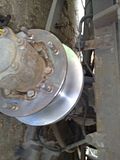
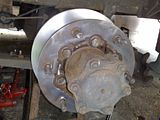
In preparation for refitting the caliper bracket, I stripped the sliders down. These can be prone to siezing (more so on some vehicles than others) if not serviced properly. It is pretty simply to do, they simply pull out and the dust cover pulls off. I cleaned them off with an old rag and then coated liberally with anti-sieze compound. Re-assembly followed during which I worked them back and forth to ensure that the anti-sieze was spread evenly inside and that they were functional. I also cleaned the heads of the sliders to ensure that spanner would fit on any of the faces.
I re-fitted the bracket to the hub with the 2 19mm bolts and some thread locking compound (don't want brake parts coming loose). The area of the caliper bracket where the pads slide was also cleaned as even small amounts of build in these areas can cause the pads to stick which can reduce braking efficiency dramatically.
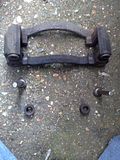
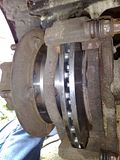
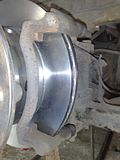
Before refitting the caliper and the new pads, the pistons needed to be pushed back. Luckily they weren't extended too far as the pads on the vehicle were only about 5-10% worn. I don't know why they didn't replace the discs when they puts these pads on as they can't have been on for very long (especially as this was an ambulance). I could have re-used the old pads, but will rather put them on the shelf for the next time as I think new discs deserve new pads.
On advice from my friend Peter, I attached a bleed hose to the bleed nipple and cracked that open while pushing the pistons back with a clamp. This would ensure that the old fluid escapes rather than being push back up the line into the ABS system.
The picture below also shows where the new sensor wire plugs into a recptor on the caliper (They didn't bother with the wires during the last pad replacement). You should however fit the sensor wire to the pad first (I learnt this the hard way).
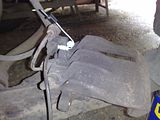
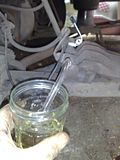
The pads were then slid into place and the caliper remounted using the 13mm bolts. As I had bought the pads from Mercedes thay came with new bolts that have a thread compound pre-applied. If you are re-using the old bolts, make sure you use some thread locking compound on these safety critical parts. The sensor wire was fed through the hole in the caliper and plugged in.
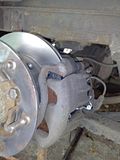
The final step before refitting the wheels and repeating the procedure on the other side was to adjust the handbrake shoes. This was done by turning the disc to align the adjustment hole with the 'geared' adjuster wheel (just visible in the picture).
The adjuster was wound out using a screw driver until the handbrake shoes held the disc. It was then freed off again until just free. Remember that I had slackened off the cable adjustment under the vehicle prior to this. Once both wheels had been completed I adjusted the cable adjuster under the vehicle (picture below - this is done by releasing the 13mm bolt, twisting the cam - using an allen spanner - and the tightening the 13mm bolt) until the handbrake lever took with about 5 clicks. I also sprayed the cable adjuster liberrally with anti-sieze spray. I intend to remove and service this at the next service, but don't believe this needs to be done for the MOT re-test.
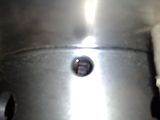





Hi Craig. I also have an ex 2001 ambulance 413 CDI. 16,000 miles ago I had the cables, pads and shoes and discs replaced on the rear. Yesterday I asked my local garage to adjust the handbrake as there was too much travel. They told me that both drums were split and needed replacing. When I told them the mileage that had been done since the last replacement, they suggested that it could be due to lack of usage and if laid up for long periods of time to leave the handbrake off and chock the wheels. Any comment? Regards, Alan
ReplyDeleteHi Alan,
DeleteThanks for visiting, I haven't had the problem you describe, so can't comment on that specifically, but all my mechanical experience leads to the following conclusion.
1) I would agree that for long periods of inactivity it would be best if you are able to chock the wheels and release the handbrake, but this is more to do with not having the cable under tension or the parts "freezing" (actually rusting or otherwise) into position.
2) I can't see how leaving the handbrake on over an extended period will split the drums unless they had an inherent fault. This pure materials engineering. If the drums were going to split from that force then I can't see how they could have been safe for the forces under emergency braking. I would question the quality of the parts fitted before, or the opinion that they are split.
I have seen discs/drums that look as if they have a crack in them, but on closer inspection it becomes clear that it is a mark left by the pads/shoes.(not saying this is true for your case).
Thanks. This has saved me a garage bill. 15 clicks to 5..
ReplyDeleteHi I have fitted all the parts you have but my handbrake is still going all the way to the top,is that because I have not adjusted that cam thing under van or would it be a stretcher cable? Thanks in advance
ReplyDeletePaul
Hi Paul,
DeleteI couldn’t say for certain and I sold this van a number of years ago. I could be either of what you suggest. I’d personally have a look at the cam as mine needed some good cleaning IIRC. The same applied to my ‘47 Chevy.